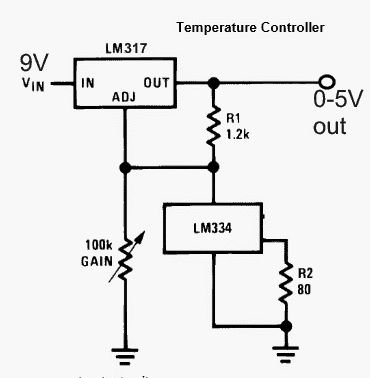Temperature to voltage converter is a device which converts each degree rise in ambient temperature into a corresponding rise in the output voltage from the device.
It is easy to build the circuit of temperature to voltage converter having a range between 0 to 24 ˚ Celsius ranges of temperatures.

Main Features
The final output of the circuit of this thermometer is around 500 mV/˚C. The temperatures are readable on a Voltmeter that has degree Celsius calibration.
In building such a thermometer, a negative temperature co-efficient thermistor or NTC is used to keep the circuit simpler and more accurate. The advantage of using an NTC is that the temperature co-efficient of resistance is large enough.
However, there is the disadvantage that the temperature coefficient does not remain constant when such NTC is used.
This results in nonlinear temperature-voltage output. However, for this particular simple temperature to voltage converter, within the range of 0˚ to 24˚C the linearity is good enough.
Construction Hints
To build the converter, an op-amp IC1 has to be connected as a differential amplifier.
This amplifier gets the feed from four legged bridge consisting of four resistors, R1 to R4. The fixed arms of the circuit bridge consist of R1, R2, R3 and P1 while R4 acts as the variable arm.
In such a circuit, the voltage at the connecting point of R1 and R2 is about 3.4 Volts. The NTC is kept at 0˚ C.
How to Setup the Circuit
This is when P1 is adjusted to get a zero op-amp output when the voltage at the juncture of R3 and R4 is also 3.4 V.
As temperature rises, the NTC resistance goes down, making the voltages across its ends fall down further. This leads to an increase of op-amp output.
To make the output exactly 0.5V/˚C the R8 and R9 resistors may be adjusted. It is notable that the value of R8 and R9 should be same while doing so.
Whcin Op Amps can be Used
General purpose op-amps, such as 741, 3130, and 3140 can be used as an IC. In case of 741, no compensation capacitor is required. R4 can be built with any 10k NTC Thermistor.
However, the smaller the size, the faster are the results due to lower thermal inertia of the thermistor.
Similarly, there is no restriction of using the 5k or 15k ones, but the values of P1 and R3 must be altered in a given ratio.

Leave a Reply